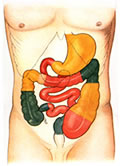|
by Allison Kozicharow
What is the saving power of Oral Rehydration Therapy, known as ORT?*
One child is dying from dehydration. Someone gives the child badly needed water. The child's body cannot absorb the water and the child dies. Another dehydrated child is given water mixed with a simple formula of sugar and salt. This, the child's body can absorb, and the child lives.
People dying out of ignorance is unacceptable. And because WiRED believes that community health starts with knowledge, we have incorporated ORT into our Community Health Information (CHI) library of more than 100 health topics—most recently reaching remote communities in the Peruvian Amazon. Our program and community seminars will provide educational tools that show how ORT works and how to prepare and administer it without medical help.
 Although many organizations and medical institutions are promoting ORT, amazingly, the technique still is unknown in many regions of the world, while children, mostly, die of dehydration from typhoid and other gastrointestinal illnesses such as diarrhea. According to the World Health Organization (WHO), ORT is credited with saving 1.5 million to 2.5 million lives a year among children who, without ORT, would have died. In addition, ORT reduces the severity of diarrhea and vomiting, the number of hospitalizations, the need for costly intravenous fluids, and the length of treatment and onset of secondary infections.
Scientists first researched ORT in the 1940s, but it was twenty years later before the idea was successfully formulated. ORT was developed and enhanced by, among others, WiRED board member Robert Northrup, M.D. who during the early sixties was part of the ORT development team at the ICDDR,B (International Centre for Diarrhoeal Disease Research, Bangladesh).
Dr. Northrup said, "My role was in the initial studies of patients where we proved that by adding glucose we could produce massive absorption of fluid and salts despite the toxin produced by disease. With that in hand, it was a matter of tinkering with the formula and working out how to get it out to the people that made it such an amazing success."
Dr. Northrup went on to say, "Water is such a critical element in health! Where clean water, uncontaminated by humans or animals is lacking, water is the source of much of child illness such as diarrhea and of nearly half of child deaths. The irony is that mixing ORT is perhaps the only time use of contaminated water is allowed. Although clean water is always preferred, when a child is dying from dehydration, speed is so important to ultimate survival that WHO recommends using whatever water is available, so that time will not be lost in searching for fuel and boiling the water to make it clean."
ORT's simple, highly-effective, lifesaving approach to dehydration fits in seamlessly with WiRED's established work of filling a vital niche in improving community health through available, accessible, and comprehensive grassroots education.
*Oral Rehydration Therapy, which uses Oral Rehydration Solution, is sometimes referred to as ORS.
- 1940s
- First recorded research but unsuccessful
- Stumbling block: the absorptive mechanism had been put out of commission by the toxin produced by the disease
- 1960s
- Testing of various combinations of glucose and salts
- Successful formula developed
- 1970s
- ORT used successfully in war between India and Pakistan
- Proof that ORT could be given by non-medical personnel, volunteers, and family members
- 1990s
- Improvement of home management of diarrhea through ORT
- 2001
- ORT formula of salt and glucose released by WHO
- Present
- WHO continues to expand and promote use of ORT

Layout by Brian Colombe.
^ Back to the Top
|



